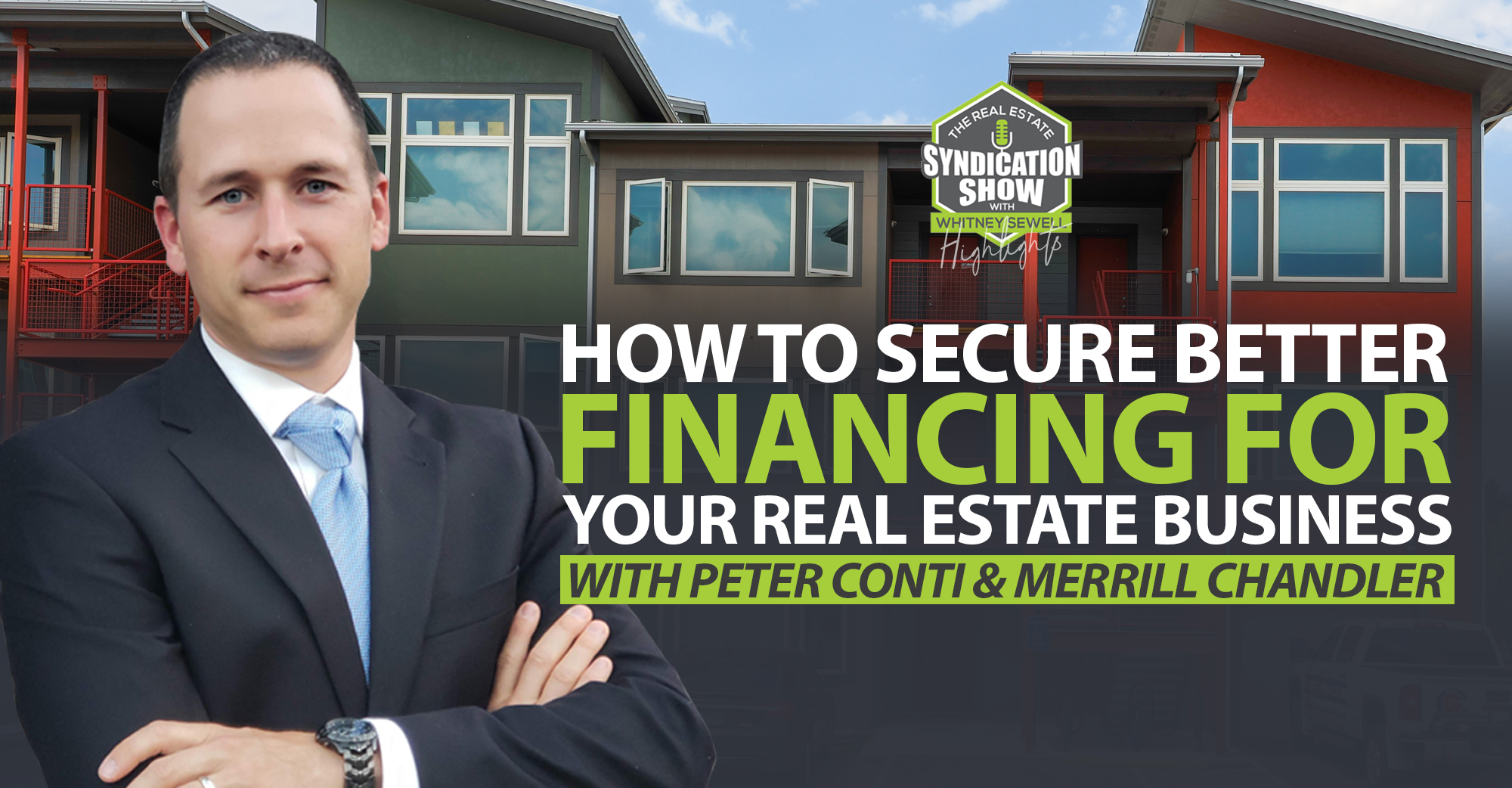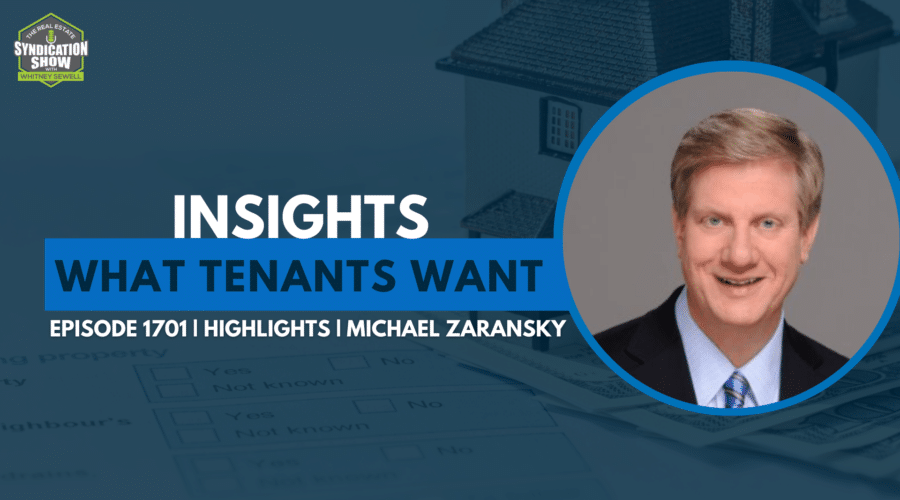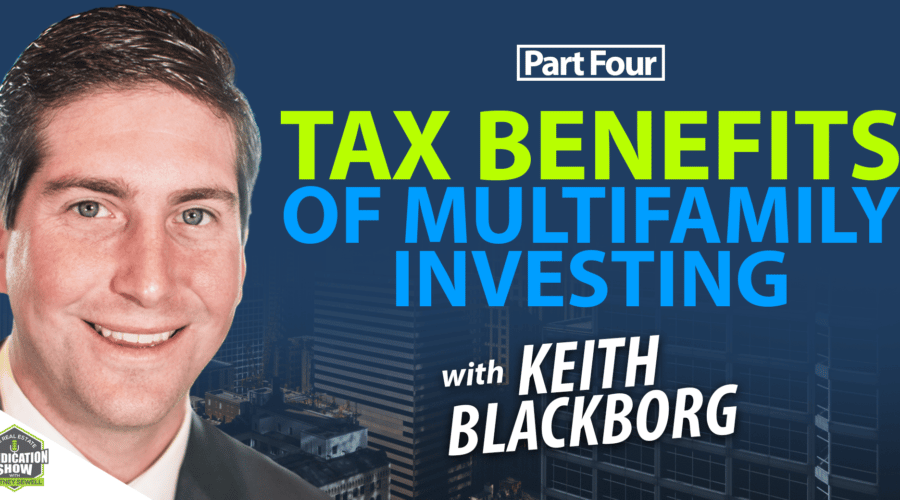Getting into real estate entails the need for enough finances so that a deal can push through. For some investors, this means a need to look for financing or borrow money. In this Highlights episode, we look back at our conversations with real estate mentor and author Peter Conti and Merrill Chandler of Fundable.com.
Watch the episode here:
Listen to the podcast here:
Peter unpacks his ideas on talking to owners, getting them on board with financing, and the way he managed to quickly build his portfolio and business. Peter also talks about deal breakers, direct connections, and the guts to take the next step. Meanwhile, Merrill shares some actionable advice on how to go from a consumer-borrower to a professional one. Merrill highlights how debt like mortgages, auto loans, and credit card debt directly influence your ability to get business credit. Listen now and secure better financing for your business!
Key Points From This Episode:
- The sweet spot that Peter found where owners often seemed willing to help with financing.
- Growing the business from properties to teaching, mentoring, and deals across the country.
- Peter’s advice for hopeful millionaires wanting to up their game to real estate deals.
- Connecting directly with owners instead of only dealing with agents and middlemen.
- Peter’s dealbreakers; things that decide whether he is in or out.
- Merrill’s tips on getting your business and personal profile in top credit form.
- If you can show up in stressful times, your lenders will remember you in prosperous ones.
- Insight into some of the 40 different borrower behaviors that lenders look at.
- Find out more about what Merrill does to help clients become ‘fundable’ in 24 months.
- How to move from being a reactive, unintentional borrower to a proactive one.
- The interlinked nature of personal and business credit.
Tweet This!
“Get enough information to be able to know how to value a multi-unit property, using a cap rate formula at least, would be one of the very first things that you would need to do.” — Peter Conti
“The more tools you have to put a deal together, the better your chances are of making a deal that is really a win-win for everybody.” — Peter Conti
“One of the things I learned many years ago is that you can have your price or you can have your terms but you can’t really have both. So it is working between those two dynamics.” — Peter Conti
“First thing, you got to learn the rules of the game.” — Merrill Chandler
“80% of the business lending decision depends on your personal borrower profile, only 20% depend on your business information.” — Merrill Chandler
“Now, remember the higher value that you have on your personal profile, those relationships leverage over under the business division banking of those same institutions, and there are ways to play that game. When you know the rules, you can master the game.” — Merrill Chandler
Links Mentioned in Today’s Episode:
WS308: Smart Ways to Find Your Way Around Financing with Peter Conti
WS614: Becoming A Professional Borrower with Merrill Chandler
About Merrill Chandler
Over 25 years ago, Merrill Chandler—a personal and business credit pioneer and co-founder of Lexington Law Firm—became dissatisfied with the ineffective results of credit repair. Leveraging his extensive knowledge of borrower behavior profiles, FICO® scoring metrics, and lender underwriting requirements, he developed a process that could ‘optimize’ a consumer’s borrower behavior AND improve a borrower’s “fundability.” He founded GetFundable.com to deliver this revolutionary technology to real estate investors, business owners, and entrepreneurs nationwide. Merrill has helped thousands of borrowers become more FUNDABLE and help them access the capital they need to fulfill their financial dreams.
Insight into some of the 40 different borrower behaviors that lenders look at. Find out more about what Merrill does to help clients become ‘fundable’ in 24 months. How to move from being a reactive, unintentional borrower to a proactive one. The interlinked nature of personal and business credit.
About Peter Conti
Peter started investing in commercial real estate in 1990. He went from auto mechanic to self-made millionaire in 3.5 years. Mr. Conti has helped thousands of real estate investors through his books, courses, and mentoring. Now, mostly retired, Peter selects a handful of people to mentor each year. It was almost 30 years ago that Peter Conti went from mechanic to millionaire by investing in commercial real estate. Since then he’s helped thousands of other people successfully transition into both commercial and residential real estate. After sustaining a serious injury from a motorcycle racing accident, Peter hiked the 2,190-mile long Appalachian Trail in order to heal his injured leg. Now, Peter claims he’s mostly retired, yet he still takes time to personally mentor a handful of clients each year. His personal interests include playing piano, helping others recover from traumatic injury, and performing improv comedy. If he’s not traveling to visit his kids and grandchildren, you’ll find Peter relaxing with his wife in Annapolis, Maryland at his home on the Chesapeake Bay.
Full Transcript
EPISODE 1022
[INTRODUCTION]
0:00:00.0 ANNOUNCER Welcome to the Real Estate Syndication Show. Whether you are a seasoned investor or building a new real estate business, this is the show for you. Whitney Sewell talks to top experts in the business. Our goal is to help you master real estate syndication.
And now your host, Whitney Sewell.
00:00:24.000
Whitney Sewell: This is your daily real estate syndication show. We are introducing a new segment called The Real Estate Syndication Show Highlights, where we’re bringing you a look back at episodes focused on a specific topic that we believe added a lot of value to you in your syndication journey.
Don’t forget to like, share, and subscribe. Also, hit the notification bell so you can continue to know when new shows come out. Have a blessed day!
[INTERVIEW 1]
00:00:49.0
WS: Our guest is Peter Conti. Thanks for being on the show, Peter.
00:00:52.0
Peter Conti: Great to be here. To all of you listening, great to be here.
00:00:54.0
WS: Where do I even start Peter? You know, I’d love the syndication model, I’d love to be buying apartments or talking to investors but I just don’t feel like I can even do that or I don’t have the confidence yet. You know, from your experience, now, you’ve coached many people through this process, what do they need to do to get this in their mind that you know, I can do this and I got to start creating some traction?
0:01:14.8
PC: Well, I think beyond the basics of being able to – through books or courses or just listening to podcasts, get enough information to be able to know how to value a multi-unit property, using a cap rate formula at least, would be one of the very first things that you would need to do. The best way to do that is to learn what the formulas are and then go out and apply them. Call up some brokers or get some properties of LoppNet, take the income expenses and do the math on it to figure out what you feel that the property is worse so get more comfortable with that.
The next step and one of the things that I urge my clients to do is find ways that they can get
connected directly with a seller of a property. Now, if properties are listed with a broker, as you know, a lot of times, these brokers aren’t too willing to turn over the phone number or contact information of one of their listings to someone they just met that morning. But what I found is that through a combination of doing some things, so you can connect with owners yourself directly and there’s things you can do, you can mail sellers, even better just go knock on some doors, talk some tenants, find out what the owner’s phone number is and call them up yourself directly or go to an apartment owner’s association if you can find one in your area and meet some other people there that know the properties and just start a conversation, a dialog with them yourself directly.
As far as being able to connect directly with sellers on properties that are listed, one of the things we found that’s helpful is getting an offer out on the property that you know probably isn’t going to get accepted, it’s not a super low ball offer but lower than let’s say the seller or broker expected offer and when that offer isn’t accepted, what we say to the broker is, “Hey, we can probably put this deal together, is there any way that we could all get together and just put our heads together on this? You, the broker, myself and the owner of the property. Do you have a conference room or something where we could sit down in the median and find a way that all three of us could get together.”
And I found that when we do that, that’s the quickest way for us all to get to the closing, so we can all get paid? With that language pattern, what I’m doing is I’m pushing the broker’s buttons on talking about getting his commission paid. Yet I’m doing it in a way where I’m respecting and making the broker feel comfortable that we’re not going to go around them, we’re not going to try and put some deal together directly with the seller where the broker isn’t compensated.
0:03:27.3
WS: Yeah, it’s in his conference room, right? I mean, I like to tell you that I was awarded that. It’s not threatening, it’s not hey, can you just give me the numbers so I can talk to him myself. You know, it’s hey, can we use your conference room and so we can make this happen, that’s awesome.
0:03:29.5
PC: Yeah, I found that from a negotiating standpoint, when you’re doing deals and this is for any type of property, whether it’s a single family home or a big commercial triple net property, if you can find out really what is going on. So, one of my favorite questions for the broker or the owner if you are talking to directly is, “Wow, this seems like a wonderful property.” Don’t they all look wonderful when they look at the pro formas and the information that they give you up front? “It looks like a wonderful property, why would you ever consider selling it?” And you just shut up at that point and listen and we may not get the right answer right up front but if you are engaged and can create a connection with a seller. Create a little bit if a rapport, one of the things that I have encouraged my students to do over the years is if you can find someone that’s been in real estate a long time and you can help them to see you as a younger version of
themselves, for people who are listening, if you feel like you’re maybe not old enough to be making money in commercial real estate, you need to use your youth to your advantage. If you can get the seller or the owner of the property to see you as a younger version of themselves. Who is willing to go out despite not having done hundreds of deals, despite not having millions of dollars in the bank that you have to work with, capitalize, you are willing to go out and say, “I believe in commercial real estate and I want to buy your property. Here is why, can you help me come up with some ways to do that or how can we figure that out together?” It really makes it where, rather than an adversarial relationship, it is much more encouraging that seller in you to step together onto the same side of the table and put together a deal that works for everybody.
0:05:12.2
WS: So multifamily has been your focus, right?
0:05:14.0
PC: Yeah, multifamily for the most part. I have done a variety of other commercial asset types, for example I own a part of a shopping center down in El Paso, Texas right now, which has been a great investment and I have also been involved in helping people with single family homes all across the country. We used to teach a lot of lease option type stuff. And interestingly enough, I found that with a commercial property, not with something that is a retail deal.
And they are in no rush to sell it but if you find a property owner who is motivated and has a problem they want to solve, sometimes you can put that together by doing basically a lease option on a piece of commercial real estate. It is called a master lease and it is something that can be very effective. Again, it is not going to work just calling up a broker that doesn’t know you and saying, “Hey, I want to do this deal,” but if you find the right seller, who has the right situation one of the things that I have seen drive master lease deals before is the fact that when someone is selling their property. If they have owned it for 23 years or 40 years, the property is fully depreciated. If they sell it, they’re going to have to recapture all of the depreciation that they have taken over the years and they are going to have a fairly good tax bill unless of course they get a 1031 over into another property. If someone is getting on in their years and they really don’t want to own more property, you can structure a master lease agreement where they are getting ongoing income from that property. They don’t have to worry about the day to day stuff. You take care of that for them. And the title actually changes hands after they pass on and that ends up saving their children quite a bit of money in taxes that they would have to pay otherwise.
Now people don’t do deals just for tax reasons, so we don’t lead in with that but that is one of the things that once you get talking to them and trying to explore different opportunities, we use language like, “Well gosh, I don’t know if this will work or not.” But another property, a friend of mine was talking about on a podcast I was listening to the other day, put together a deal that was structured something like this. They came in and they basically paid X amount for the property. Each and every month the same amount so you wouldn’t have a month where it’s costing you and then you make more one month and then you have the big expenses the next month. You would have a secure steady income of property every single month.
I will collect the rents, I will take care of paying all of the expenses even the property taxes and you will get your said amount each and every month. All we need to do is agree on what that amount is and of course, a fair price that I can agree to cash you out of the property at some point. We need to figure out when that day would be.
0:07:44.6
WS: Interesting. So when looking at deals and let’s say now as experienced as you are, what are some major deal breakers? Just initially two or three things that, “Okay if this isn’t this or if this isn’t this way, I am not going further.”
0:07:58.5
PC: Well generally the deals I am involved in, I tend to be pretty picky about the clients I work with because I am just working with five or six of them at a time, each year. I generally am not working with someone who started out with very little money like I did originally. I had $1,500 in the bank when I got started with my investing. I like to have at least enough money that they could have some skin in the game if they’re putting together a deal and bringing in other investors.
And I think in this environment that we have going on right now where cap rates are getting compressed and it just seems like it is getting more and more competitive, the more tools you have to put a deal together, the better your chances are of making a deal that is really a win-win for everybody. So generally, we’ll go out and oftentimes make an offer to do a more conventional deal where it is a 20 or 30% down payment and then new financing and we’ll also engage in talking with the seller.
Again, if we can do it directly with the seller while keeping the broker respected and appraised what is going on, you can sometimes put together a deal. If someone is price sensitive and they are not willing to drop on their price, they might go ahead and do a creative deal where maybe they do carry back the financing themselves just because they can have that feeling of “I wanted to sell my property for $5 million,” or whatever it is that is driving them.
One of the things I learned many years ago is that you can have your price or you can have your terms but you can’t really have both. So it is working between those two dynamics.
0:09:23.6
WS: Nice. So in your experience and obviously the success you’ve had and obviously coaching so many people, what has really been the hardest part of either the syndication process or just purchasing commercial property in general, for you?
0:09:34.8
PC: I think probably something that took me a number of years to learn and something that I need to drive in to some of the students I am working with is it is one thing to listen to or read a book about syndication and say, “Great, I am just going to find other people, doctors or dentist or people that want to make higher rates of returns.” Understanding that if someone is going to invest in your deal they’re really investing in you and they need to know, like and trust you. Before you ever even get to explain to them what the rate of return might be.
A lot of people have the feeling that — I talk to people sometimes and they have never done a
deal before. They don’t have any background or experience in real estate and they somehow want to be able to go out and do a $20 million deal and bring investors into it when they haven’t taken the time to take the baby steps and get going first, which is why I encourage people to get out there. Maybe do some smaller properties on their own or find a ten unit property that you can maybe find one money person that go in and your deal with that money person is you put up the money, I find the deal, I’ll put in all the work and effort and we will split the profits on it 50-50.
Now, you can get a better deal than that with investors in the future but be willing to give more
than you need to in the beginning just to get your feet wet and start to develop yourself as an experienced investor rather than someone that comes across there as real greedy.
[INTERVIEW 2]
00:10:51.0
WS: Our guest is Merrill Chandler. Thanks for being on the show, Merrill.
00:10:53.0
Merrill Chandler: I’m so glad to be here, Whitney. So glad.
00:10:56.0
WS: So, help us to become that professional borrower. How do we do that in the next 24 months? How do we become the most professional borrower and have that type of profile?
0:11:07.0
MC: All right. So, I did want to say kind of what the result is. You would ask me what we need to prepare for. There’s two points I wanted to make. In perspective, I think everything that I do is based on targets, so the bull’s eye is where we want to be. Most people aren’t even fundable enough to hit the target at all, right?
But when you are fundable, meaning to some degree, and you can hit the target, then the problem becomes in times of recession, the target becomes smaller. So, fundability optimization, what we do, what we talk about in every platform that I’m on, deals with how to make your scatter chart within that bull’s eye first ring, right? So, it doesn’t matter whether you’re in prosperous times or the lenders are tightening up their criteria. Lenders only make money when they lend. So, if you are in that bull’s eye scatter chart, you’re going to still keep getting money.
My clients, we’ve already got $1.3 million so far in May in fundings from top-tier banks, because they keep getting that small tiny scatter chart. Now, to answer your question, how do we change what we need to do in the next 24 months, right? First thing, you got to learn the rules of the game. Most of us, before we come to this, we are literally playing pickup games at the rec center and we’re playing against all-star pro NBA ballers, right? We’re getting dunked on and dunked on. It’s like the Harlem Globetrotters. They’re just killing us, so we got to first learn the rules of the game. The rules of the game include those 40 characteristics that we need to become aware of. Some of which I’ve already mentioned.
The second thing is the awareness of a consumer borrower means that you are picking up types of credit that are harming you. Here’s the perfect example that some – You guys can stop right now and improve your profile. If you go to optoutprescreen.com, optoutprescreen.com, and take your name, address, phone number, everything off of the credit bureau mailing list, your profile value will increase by 10 to 15% because you’re not on the list to be offered credit. Now, just so, lenders I have mad respect for their system and their marketing savvy. But do you realize many credit offers are literally pinging consumers to see if they should be taken off the serious borrower list, meaning you’re being pinged with a credit offer? If you get approved, then you end up on – It’s my term but it’s a susceptibility list. The reason why your credit score and your fundability goes down is because you will respond to offers.
Lenders do not like to lend to people who need money, so your borrower behavior has to shift so that you appear in every way not to need money, and so the insider secret here is if you get an offer, let’s say in the mail, “Hey, it’s a $50,000 business line of credit from Wells Fargo,” do not ever under any circumstance anywhere input on the form the tracking number, the activation code, the pin, whatever.
Call up Wells Fargo and ask them about their $50,000 business line of credit, because now you are a proactive intentional borrower, rather than a reactive, unintentional, I’ll-take-whatever-money-you-throw-at-me borrower. In the book, we talk about what we call borrower totems, right? There’s different animals. That’s a seagull borrower, right? Pick up the scraps. Anything you got, I’ll pick up any type of credit that you are willing to offer me. Professional borrowers are intentional borrowers. We do not respond. We proactively seek.
The other thing that your people need to really understand and this comes directly from David Smith. He is the SBA. When I was at FICO, I did a podcast and I interviewed – At FICO World, I’m interviewing the SBA liaison with FICO and Congress, and he’s the guy who reports to Congress and literally tells Congress how well the SBA portfolio is doing, right? Well, now we have gobs and gobs and gobs of PPP loans and the EIDL loans. Do you know how they evaluate the credit of individuals for the PPP loan? It’s called SBSS, Small Business Scoring Service, and it uses the FICO liquid credit engine.
But people think that business credit depends on the things that they have been taught in the past. Some of the mythology has been around the PAYDEX Score or the Experian Intelliscore. No credible credit bureau scores its own data. It’s illegal for Experian, TransUnion, Equifax to score its own data. That’s what FICO is responsible for taking the data and scoring it. Well, on the business side, the Fair Credit Reporting Act doesn’t exist, and so FICO has just barely in the last few years been moving into the business scoring market.
In this podcast, David Smith, FICO, told me that 80% of a business lending decision, 80% of the business lending decision depends on your personal borrower profile. Only 20% depend on your business information. Not your business credit score, not your business trade lines, and they look at the business identity to make sure it’s not fraud and that your personal borrower identity and the business borrower identity sync up. That’s the other of what we call in the bootcamp, the other 20%.
0:16:51.0
WS: It’s important what you’re doing with your personal credit if you expect to get business credit.
0:16:55.0
MC: Absolutely. 80%. Because David also said in this podcast that business credit reporting today is the equivalent of what personal credit reporting was in the mid-80s, literally 40+ years ago. It’s still the wild, wild West in business credit reporting, and so FICO is coming into this space and will dominate just like it does on the personal side. But right now, we need to understand that our personal profile, just like you said, Whitney, drives business approvals. The magical thing that he said was we have to optimize the personal profile for business underwriting. That’s why we can’t have the consumer.
People ask me all the time, “I have an $800+ credit score,” and it’s based on consumer accounts. You have a perfect payment history. I always ask, “Do you believe the Chase is going to give you a 50 or 100,000 dollar business line of credit based on your Home Depot reputation?” It is never going to happen, so we have to build a personal profile that completely encapsulates what a business lender wants to look at.
0:18:03.0
WS: Give me a couple things that will help us do that. I know we all learn those rules and then not have harmful types of credits or we’re not going to go finance furniture. Or we’re not going to just take in any kind of credit that they send us like you were talking about. What else is going to help us to have that profile?
0:18:17.0
MC: Credit offers. One of the things that we can be aware of, this one’s huge, there are FICO scores and there are FAKE-O scores. If you’re playing a basketball game and you’re using a fake score to evaluate your credit, that’s like believing somebody holding up a poster in the stands and not looking at the official count on the scoreboard on the wall, right? Well, perfect example, and this is a travesty. Do you realize who the purveyor of the greatest, greatest, most horrible FAKE-O scores out there? Credit Karma. 80 million people are using scores. They’re basing their credit belief, their credit financing capability, and their actionable intel on a fake score because no lender uses Credit Karma scoring model. Nobody uses it for approvals, especially for high-value accounts; automobiles, mortgages, tier 1, tier 2 bank cards, credit cards, things like that.
All of a sudden, we have 80 million people who are evaluating their fundability on a fake score and they wonder all the time. A woman came to my bootcamp, and she was just devastated when she learned about the fake scores because it totally made sense why she went to buy a car, and her credit score on Credit Karma said 720 on her phone. Then they walk in and the auto dealer is pulling a 650-credit score. She’s devastated, right?
0:19:44.0
WS: So, should we have debt on our cards? Should we have credit card debt, which we do to help build that profile to show that?
0:19:52.0
MC: Another set of criteria, kind of the rules of the game, right? The highest and most valuable credit profiles to the lenders are, one, they have at least one mortgage. It doesn’t matter the amount. It could be a $20,000 HELOC or a $1.2 million first. Doesn’t matter. At that level, it doesn’t matter. An auto loan, it doesn’t matter if it’s a $5,000 one or a 3,000 or a 50,000 or you got your Maserati at 150, right? It doesn’t matter as long as it says auto loan on it, because FICO is about predictive analytics. If you have an auto loan and a mortgage, you are in what’s called the scorecard. You’re in the scorecard that has the least likelihood of default or bankruptcy, so those two.
People ask all the time. You’ll have listeners I’ll bet you that’ll comment or otherwise like, “Yeah. But I paid off my car and my score went down 20 points. Why? I thought that’s a good thing?” The credit reporting and scoring process is the quintessence of what have you done for me lately. So, if you pay it off, that’s not a good thing because you don’t have a trade line that proves that you’ve got the chutzpah to continue to pay. One auto loan, one mortgage where possible. Don’t go into debt intentionally if you can’t afford it, guys. That’s no bueno, but I’m telling you what is most valued in the process.
The next thing is that you want three tier 1 or high-value credit cards and the tier 1 banks are Wells, City, Bank of America, Chase, which are too big to fail. Tier 2 are all the regional banks, the BB&Ts, the US Banks, the California Banks and Trust, the ones that are regional and cross state lines, etc., etc. Those are the top-tier. Tier 3 are like credit unions and community banks, and so, tier 3 banks are less valuable to business lenders than tier 2, which are less valuable than tier 1.
Now, remember the higher value that you have on your personal profile, those relationships leverage over under the business division banking of those same institutions, and there’s ways to play that game. When you know the rules, you can master the game. Ethan Dornhelm, the Chief Scientist at FICO told me when I asked a very pointed question. I said, “What is a zero balance because our numbers, our algorithms said that a zero balance is not good?”
He said, “I can’t tell you the math but less is better than more, but some is better than none.” So, our numbers showed that but we worked that out so that – Remember I spoke about the reporting date. You can have a false high balance. So, there’s a way to find out your reporting date and then make a payment before the reporting date, in addition to paying it to zero on the due date. That’s a strategy that will make sure you look good when you’re broadcasting to lenders in the future.
0:22:55.0
WS: So, it never shows a really high balance?
0:22:58.0
MC: Correct. That’s correct. Yet so many people cross over. They pay it to zero but they’re in the middle of using it all the time. When it crosses that reporting date, that use balance is what gets reported, not your zero balance at the due date.
0:23:15.0
WS: So, we want the reporting to be zero. Is that right?
0:23:16.0
MC: We want to pay zero at the due date but we want – There is a percentage. It’s less than 30% but it’s customized. I think of everybody’s borrower profile as a pie chart. Depending on how many accounts you have, how many are open, how long they’ve been open, the quality or tier of the accounts, it all contributes to an algorithm that basically says what the percentage should be for each particular account. Every account is a different percentage which equals 100%.
But that’s part of the magic, right? I’m a total geek for this stuff, and so we’ve not only been back to FICO, but our modeling is spot on with regards to what they have, what the lender-facing side, and the borrower-facing side are synced up when it comes to the dots we’ve connected.
[END OF INTERVIEW]
00:24:01.0
Whitney Sewell: We hope that you enjoyed the Highlights show today. You can always listen to the full episodes that were featured today by clicking the links in the show notes page. And in the description box, let us know what you’ve thought of this episode or you can go to lifebreidgecapital.com/podcast and click the feedback button. Let us know how we can add value to you. Thank you and talk to you tomorrow.
[OUTRO]
0:24:25.0 ANNOUNCER: Thank you for listening to the Real Estate Syndication Show, brought to you by Life Bridge Capital. Life Bridge Capital works with investors nationwide to invest in real estate while also donating 50% of its profits to assist parents who are committing to adoption. Life Bridge Capital, making a difference one investor and one child at a time. Connect online at www.LifeBridgeCapital.com for free material and videos to further your success.
[END]
Love the show? Subscribe, rate, review, and share!
Join the Real Estate Syndication Show Community:







